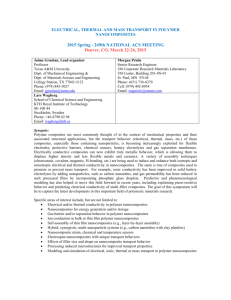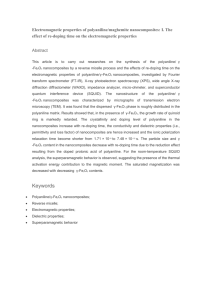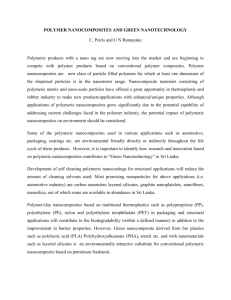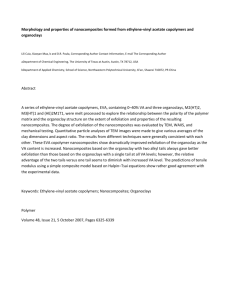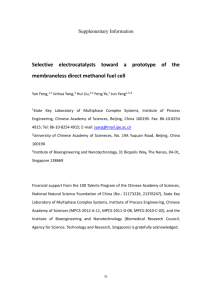Abstract summaries
advertisement
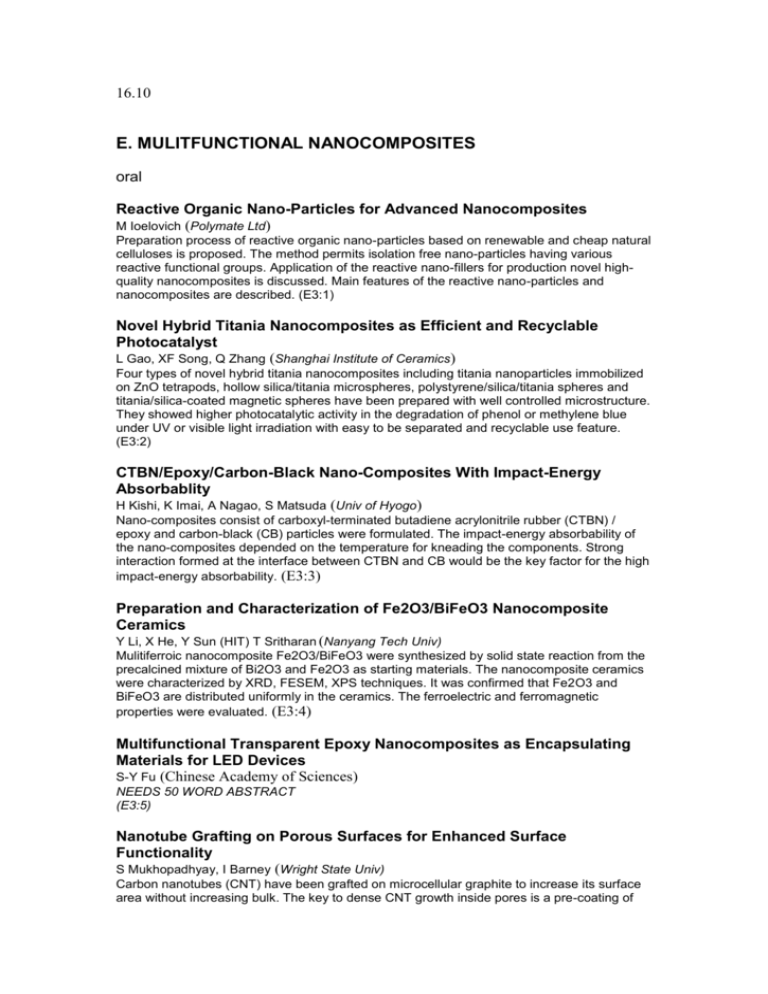
16.10 E. MULITFUNCTIONAL NANOCOMPOSITES oral Reactive Organic Nano-Particles for Advanced Nanocomposites M Ioelovich (Polymate Ltd) Preparation process of reactive organic nano-particles based on renewable and cheap natural celluloses is proposed. The method permits isolation free nano-particles having various reactive functional groups. Application of the reactive nano-fillers for production novel highquality nanocomposites is discussed. Main features of the reactive nano-particles and nanocomposites are described. (E3:1) Novel Hybrid Titania Nanocomposites as Efficient and Recyclable Photocatalyst L Gao, XF Song, Q Zhang (Shanghai Institute of Ceramics) Four types of novel hybrid titania nanocomposites including titania nanoparticles immobilized on ZnO tetrapods, hollow silica/titania microspheres, polystyrene/silica/titania spheres and titania/silica-coated magnetic spheres have been prepared with well controlled microstructure. They showed higher photocatalytic activity in the degradation of phenol or methylene blue under UV or visible light irradiation with easy to be separated and recyclable use feature. (E3:2) CTBN/Epoxy/Carbon-Black Nano-Composites With Impact-Energy Absorbablity H Kishi, K Imai, A Nagao, S Matsuda (Univ of Hyogo) Nano-composites consist of carboxyl-terminated butadiene acrylonitrile rubber (CTBN) / epoxy and carbon-black (CB) particles were formulated. The impact-energy absorbability of the nano-composites depended on the temperature for kneading the components. Strong interaction formed at the interface between CTBN and CB would be the key factor for the high impact-energy absorbability. (E3:3) Preparation and Characterization of Fe2O3/BiFeO3 Nanocomposite Ceramics Y Li, X He, Y Sun (HIT) T Sritharan (Nanyang Tech Univ) Mulitiferroic nanocomposite Fe2O3/BiFeO3 were synthesized by solid state reaction from the precalcined mixture of Bi2O3 and Fe2O3 as starting materials. The nanocomposite ceramics were characterized by XRD, FESEM, XPS techniques. It was confirmed that Fe2O3 and BiFeO3 are distributed uniformly in the ceramics. The ferroelectric and ferromagnetic properties were evaluated. (E3:4) Multifunctional Transparent Epoxy Nanocomposites as Encapsulating Materials for LED Devices S-Y Fu (Chinese Academy of Sciences) NEEDS 50 WORD ABSTRACT (E3:5) Nanotube Grafting on Porous Surfaces for Enhanced Surface Functionality S Mukhopadhyay, I Barney (Wright State Univ) Carbon nanotubes (CNT) have been grafted on microcellular graphite to increase its surface area without increasing bulk. The key to dense CNT growth inside pores is a pre-coating of reactive oxide. These hierarchical structures show significant improvement of surface related properties such as thermal dissipation, cell growth and composite formation. (E3:6) FRI 09.10 E. MULITFUNCTIONAL NANOCOMPOSITES oral Structures and Properties of Fe3O4-Carbon Multifunctional Composites Nanofibres F Ko, M Bayat, H Yang (Univ of British Columbia) Polyacrylonitrile(PAN)-Fe3O4 composite nanofibres were fabricated by the co-electrospinning process. These nanofibres were carbonized to obtain tailored electromagnetic properties. Four-probe and SQUID measurements showed tailorable electromagnetic properties were achieved by controlling nanoparticles contents and carbonization temperature. (E3:7) Piezoelectric Properties of PVDF-Carbon Nanotube Blends Y Seo (Seoul National Univ) SM Hong (KIST) NEEDS 50 WORD ABSTRACT (E3:8) Development of Numerical Model for the Complex Permittivity of the Carbon Nanocomposites at Microwave Frequency Band JB Kim, SK Lee (KIST) CG Kim (KAIST) In this paper, we have studied on the numerical model for the complex permittivity of carbon nanocomposites in microwave frequency band based on the percolation theory. The model was build up for complex permittivity of E-glass fabric/epoxy composite laminates containing carbon nano fibres (CNF) at the frequency band of 0.5 GHz ~ 18.0 GHz. (E3:9) Glass Fibre with Carbon Nanotube Networks as Multi-Functional Sensor S Gao, RC Zhuang, J Zhang, JW Liu, E Mäder (Leibniz-Institut) A single glass fibre sensor has been manufactured by depositing multiwalled carbon nanotube (MWNT) networks on fibre surface aimed at multi-functional applications. Nonlinear and linear piezoresistivity and temperature dependences have been identified in the single glass fibre sensors and their epoxy matrix composites. Our unidirectional composites exhibit anisotropic electrical and semiconducting properties. (E3:10) Onto the Internal Strain Sensing Capabilities of Single Walled Carbon Nanotube-Reinforced Epoxy Resins A de la Vega, K Schulte, W Bauhofer (TU Hamburg-Harburg) Single-walled carbon nanotubes at concentrations just above the percolation threshold were added to thermoset matrices as internal stress sensors. The Raman strain-induced shifts of the nanocomposites were investigated throughout the curing cycle and under mechanical load. Residual stresses originated from the post-cure cooling are found to affect significantly the mechanical strength of the material. (E3:11) Nanocomposites from High Surface Area Graphite from Natural Graphite Flakes and Exfoliated Graphite Nanoplatelets I Do, W Liu, L Drzal (Michigan State Univ) High surface area graphites (HSAG) were fabricated via a high energy ball milling process on natural graphite flake (NGF) and exfoliated graphite nanoplatelets (xGnP). Fundamental physical and morphological characterization of the as-produced HSAG wwere collected by using various tests. HSAG-reinforced polymeric nanocomposites were fabricated and their mechanical, thermal, and electrical properties were investigated. (E3:12) 11.30 E. MULITFUNCTIONAL NANOCOMPOSITES S Gao/S Wang oral Preparation, Structure, Performance, Industrialization and Application of Advanced Rubber/Clay Nanocomposites L Zhang, Y Wu, Y Wang, Y Lu (Beijing Univ) Clay/polymer nanocomposites have attracted great interests in the field of materials science and engineering for some superior properties. However, further development is limited by reasons like high price/performance ratio and deficiency in some properties. To break through the bottleneck we have to (1) develop preparation techniques with low cost; (2) exploit the acquired excellent properties and find optimum application fields. (E3:13) Microstructural Evolution and Electromagnetic Properties of Iron Nanofibers Synthesized by the Electrospinning Process S-K Lee, S-B Lee, J-W Yi, S-J Hong (Korea Inst of Mats Science) Y-H Choa (Hanyang Univ) To increase the electromagnetic wave absorbing properties in radar frequency region, high aspect ratio Fe nanofibers have been fabricated by the multi-nozzle electrospinning process. In the present study, the effect of different applied voltage on the morphology of electrospun Fe nanofibers was examined. The average diameter of electrospun Fe nanofibers tended to decrease with increasing applied voltage. (E3:14) Clay Effect on the Morphology and Properties of Poly(Methyl Methacrylate)/Clay Nanocomposites T-Y Tsai, M-J Lin, C-C Li, C-W Chang, C-K Wen (Chung Yuan Christian Univ) Three types of clays with different CEC are used to prepare the PMMA/clay nanocomposites by solution polymerization. The morphology and properties of the PMMA/clay nanocomposites, such as the thermal, optical, gas barrier, and anti-scratch properties would be discussed herein the effect of clay with different CEC. (E3:15) Crystallization Behavior and Physical Properties of PLLA/nHA Nanocomposites C Delabarde, C Plummer, P-E Bourban, J-A Månson (EPFL LTC) Investigations of melt compounded PLLA/nHA nanocomposites have provided evidence for a significant reduction in the rate of crystallization at temperatures greater than 110 °C in the presence of the nHA, believed to be associated with a modification in the matrix crystal structure. Possible consequences for the practical implementation of these nanocomposites in bone tissue engineering will be discussed. (E3:16)
